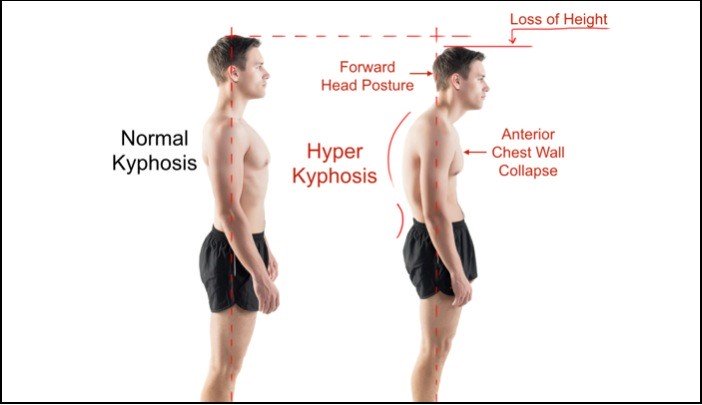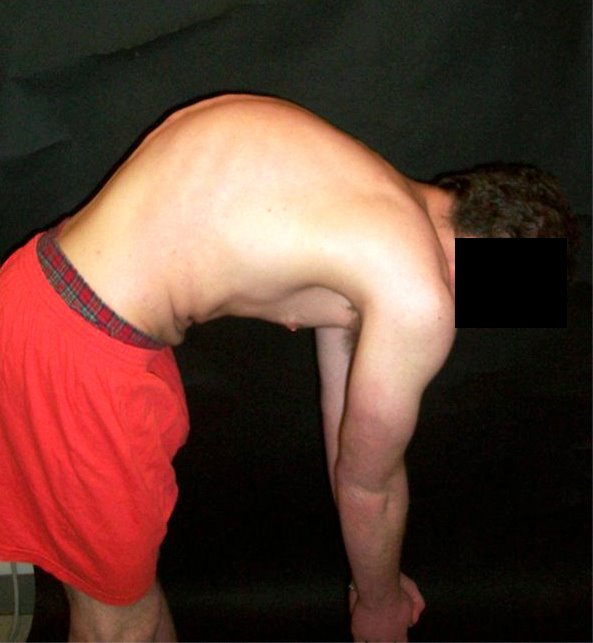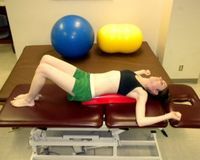nalco group
bone, muscle & joint pain physio
BOOK NOW / WHATSAPP ABOUT YOUR PAIN OR INJURY
- ORCHARD 400 Orchard Road #12-12 Singapore 238875
- TAMPINES 9 Tampines Grande #01-20 Singapore 528735
- SERANGOON 265 Serangoon Central Drive #04-269 Singapore 550265
Home > Blog > Physiotherapy > Spinal Physiotherapy > Conditions > Hyperkyphosis Physiotherapy
Hyperkyphosis Physiotherapy

Hyperkyphosis is a spinal deformity causing a forward-curved posture of the upper back (thoracic spine). Posture refers to the characteristic way you position your body and our posture changes many times throughout the day due to a variety of factors, including
- what you are doing and
- how long you have been doing it
Sometimes, however, a person's posture can cause the thoracic curvature to become excessive and stiff, making it difficult to change. Such is the case with hyperkyphosis (sometimes called “humpback,” “round back,” or “dowager’s hump”).
This condition can
affect people of all ages, but the thoracic curvature most often begins
to increase in people over 40 and continues with advancing age. It is
estimated that 20% to 40% of older adults—both men and women—will develop
hyperkyphosis
What is Hyperkyphosis?

Hyperkyphosis is a spinal deformity that occurs when the natural forward-curving shape of the upper back becomes excessive. It causes the appearance of rounded shoulders with the head and neck positioned forward of the trunk.
Unfortunately patients with this condition often have difficulty standing up straight. The worsening of the curvature is associated with a higher risk of health problems, including
Hyperkyphosis can result from conditions such as osteoporosis or thinning bones, and fractures of the vertebrae that result from osteoporosis or Scheuermann's disease.
That being said, research has found that two-thirds of people with hyperkyphosis do not have spinal fractures. Suspected causes for development of this spinal deformity when vertebral (spinal) fractures are not present are:
- Poor habitual posture
- Muscle weakness
- Degenerative disc disease
- Ligament degeneration
- Hereditary factors
Signs and Symptoms
The most prominent symptom of hyperkyphosis most patients notice is the appearance of a rounded back.
- You may not immediately recognize a change in your back posture because in most cases, the change is gradual over time. Most of the time, it is friends and family may notice it before you do.
- Other subtle signs can include changes in the way your shirts fit, feeling like it takes a lot of effort to stand or sit up straight, and feeling more fatigued with walking and other activities.
CAUTION: If you notice a sudden increase in the curvature of your back, call your doctor. A sudden change in the curve of the spine can be associated with other health problems.
Untreated hyperkyphosis can cause:
- Difficulty in the performance of normal tasks such as bathing, getting out of a chair, bending, or walking
- Decreased flexibility and strength of the trunk muscles
- Associated changes in alignment that result in a change of the body’s center of gravity and increase the energy expenditure necessary to complete common tasks
- Balance changes due to the shift in the center of gravity that can increase the risk of falls and related injury
- Upper back pain
- Spinal fractures as the condition advances
If you have advanced hyperkyphosis, you may experience:
- Difficulty breathing even though you do not have a history of lung or heart disease
- A lessening of the distance between your lowest ribs and your pelvic bones; in this case, pulmonary function tests may be prescribed to measure whether your hyperkyphosis is restricting your breathing
How Is It Diagnosed?
Hyperkyphosis will be assessed first with a visual inspection of your back.
Your spinal curve may be measured using a flexible ruler or X-ray. If an X-ray is taken, a radiologist will measure the spinal angles on the X-ray. If a curve measures greater than 40°, hyperkyphosis is diagnosed.
Sometimes spinal changes occur because of fractures due to thinning bones or a condition called osteoporosis. Of course spinal changes also can result from degenerative disc disease or arthritis.
These problems are commonly associated with aging.
Other problems not associated with aging
could also cause a sudden change in posture; however, problems such as a
tumor, infection, or neurologic changes are uncommon. Your doctor may prescribe imaging tests such as X-rays or an MRI of the thoracic
spine to determine whether you have any of these less common conditions
affecting your posture.
If you have advanced hyperkyphosis, you may experience difficulty breathing even though you do not have a history of lung or heart disease. You may also notice that there is lessening of the distance between your lowest ribs and your pelvic bones. In this case, pulmonary function tests may be prescribed to measure whether your hyperkyphosis is restricting your breathing.
how our senior physiotherapists can help

We can help rehabilitate the postural changes and functional limitations associated with hyperkyphosis.
We will begin by reviewing your past and present medical history with you as well as what medications you normally take. If you report a
- sudden change in your posture
- severe pain or
- a significant change in your physical function
you will be referred to your primary care physician. A sudden increase in the rounding of your back may indicate a more serious health problem.
When a more serious problem is ruled out, we will perform special tests to assess your unique condition. We will begin by observing, measuring, and recording your
- postural alignment
- trunk strength
- range of motion and
- flexibility in movement
If you are experiencing difficulty walking or keeping your balance, we will observe your movement and perform tests to determine the level of difficulty, and whether you have an increased risk of falling.
We will design a treatment program to address your specific needs and goals. Your physiotherapy treatment may include:
- Postural alignment training, stretching, and strengthening exercises
to help reduce the spinal curvature, decrease pain, and prevent the
condition from advancing. Adherence to the prescribed program in the
clinic as well as at home is essential for success. Most often, altering
the way you sit, stand, and complete your daily activities has the
greatest impact on lessening or slowing the progression of the curve.
- Balance exercises and walking (gait) training to increase your tolerance of activity and improve your safety by reducing your risk of falls.
- Education to improve your activities of daily
living and ease your physical functioning. Your physical therapist can
teach you how to safely get in and out of bed, in and out of the
bathtub, or out of a chair, and how to bend and walk with more ease.
- Breathing exercises to help improve your tolerance for physical activity by increasing your lung capacity.
- Myofascial/soft tissue manual therapy (hands-on
massage techniques), and in some cases joint mobilization (gentle
movements guided by your physical therapist) to help improve spinal
flexibility.
- Specialized braces or therapeutic taping to help reduce the angle of the curve.
- Pain management using modalities such as heat therapy, cold therapy, radio-frequency Indiba physiotherapy, and/or electrical stimulation such as transcutaneous electrical nerve stimulation (TENS). We will choose what modality will be most beneficial to you—and help reduce the need for pain medication, such as opioids.
Remember, all cases of hyperkyphosis are different. Our senior physiotherapist will choose the best treatment options for you based on your specific condition.
